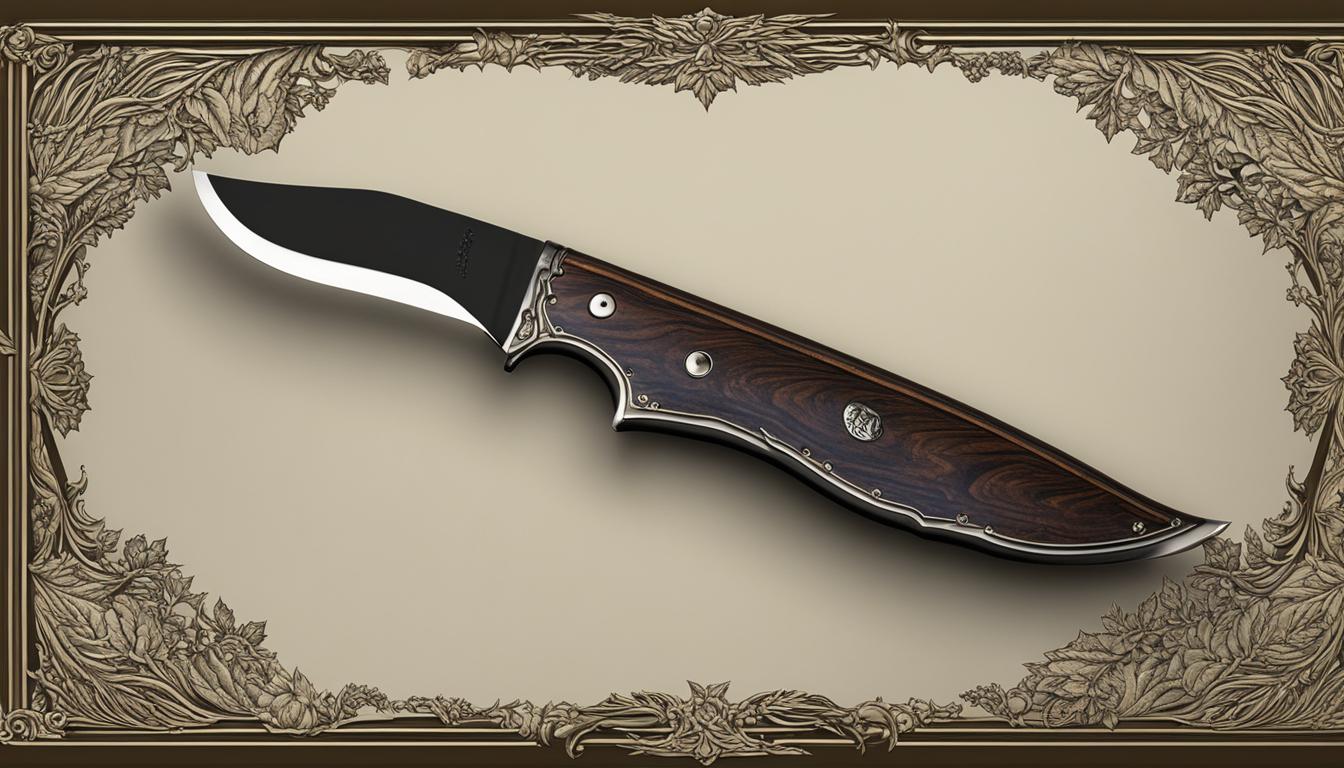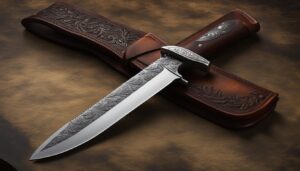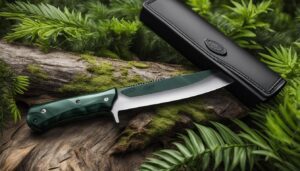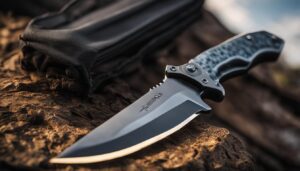When it comes to hunting knives, ergonomic design and lightweight construction are two key factors that cannot be overlooked. The comfort and usability of a hunting knife greatly depend on these aspects, making them crucial considerations for any hunter or outdoor enthusiast.
A well-designed ergonomic handle plays a vital role in the overall performance of a hunting knife. Not only does it enhance comfort during use, but it also ensures safety and efficiency in the field. A firm and reliable grip provided by a well-designed handle reduces the risk of accidents and repetitive strain injuries, allowing hunters to focus on their target with confidence.
Furthermore, the choice of materials and texture for the handle significantly impacts the grip and control of the knife. Whether it’s a handle made of wood, bone, or high-tech materials like G10, each provides added grip and control for better handling in various hunting situations.
Additionally, a well-balanced knife handle, paired with the right handle washers and spacers, enhances the overall balance and efficiency of the knife. This makes it easier to maneuver and use effectively, even during demanding hunting activities.
Key Takeaways:
- An ergonomic design is essential for a comfortable hunting tool.
- Lightweight construction improves usability and reduces fatigue.
- A well-designed handle ensures a firm and reliable grip.
- Materials like wood, bone, or high-tech substances provide added grip and control.
- A well-balanced knife handle enhances overall balance and maneuverability.
Different Types of Knife Handle Materials
When it comes to choosing a hunting knife, one of the most important factors to consider is the handle material. The handle plays a crucial role in the overall performance and grip of the knife, and different materials offer various advantages and characteristics.
Wooden Handles
Wooden handles, such as Karelian birch, box elder, and olive wood, are popular choices for hunting knives. Not only do they provide a traditional and aesthetically pleasing look, but they also offer durability and a comfortable grip. Wood handles can be shaped and contoured to fit the user’s hand, ensuring a secure hold even in wet or slippery conditions.
Stabilized Wood
Another type of handle material is stabilized wood. This material is created by infusing the wood with resins, which enhances its resistance to warping and cracking. Stabilized wood is known for its durability and attractive appearance, making it a great choice for those who want both functionality and aesthetics in their hunting knife.
Bone and Horn Handles
For a classic and rugged look, bone and horn handles are popular options. Handles made from deer horn, buffalo horn, or other animal bones provide a unique and natural texture. However, it’s important to note that these handles may be slippery when wet, so proper grip and control techniques are essential.
Synthetic Handles
Synthetic handles offer modern durability and performance. Materials like G10 and canvas micarta are commonly used for their excellent grip, moisture resistance, and ruggedness. Synthetic handles are highly customizable, allowing knife makers to create textured patterns for enhanced grip and control.
| Handle Material | Advantages |
|---|---|
| Wooden Handles | Aesthetically pleasing, durable, comfortable grip |
| Stabilized Wood | Enhanced resistance to warping and cracking |
| Bone and Horn Handles | Classic and rugged look |
| Synthetic Handles | Durable, excellent grip, moisture resistance |
Choosing the right handle material for your hunting knife depends on personal preference, intended use, and the level of maintenance you’re willing to provide. Each material offers its own unique characteristics that can enhance your hunting experience. Consider factors such as aesthetics, durability, grip, and moisture resistance when making your decision.
Next, we’ll explore the impact of materials and craftsmanship in tactical knives.
The Impact of Materials and Craftsmanship in Tactical Knives
Tactical knives are designed to withstand tough conditions and require high-quality materials and craftsmanship. The choice of materials for both the blade and handle plays a vital role in the knife’s performance, durability, and overall user experience.
When it comes to blade materials, manufacturers focus on factors such as durability, corrosion resistance, and edge retention. Some popular choices for tactical knife blades include stainless steel alloys like 8Cr13Mov, AUS-8, and S35VN. These materials offer excellent strength, sharpness, and resistance to wear and tear. Additionally, high-carbon steels like D2 and CPM-S30V are known for their superior edge retention, making them ideal for heavy-duty tasks.
Equally important is the selection of handle materials, which must provide both strength and ergonomic grip. Common options for tactical knife handles include stainless steel, G10, carbon fiber, and glass-filled nylon. Stainless steel handles offer robustness and a sleek aesthetic, while G10 and carbon fiber provide lightweight durability and enhanced grip. Glass-filled nylon handles, often used in budget-friendly tactical knives, offer affordability and resistance to impact and chemicals.
Craftsmanship is another crucial aspect of tactical knife manufacturing. Skilled professionals pay meticulous attention to detail throughout the production process to ensure precise blade construction and overall product quality. From the shaping and grinding of the blade to the precise assembly of the handle, every step contributes to creating a knife that can meet the demands of law enforcement officers, military personnel, and outdoor enthusiasts alike.
In summary, the choice of materials and craftsmanship are key factors in the performance and durability of tactical knives. Blade materials like stainless steel alloys and high-carbon steels offer strength and edge retention, while handle materials like stainless steel, G10, carbon fiber, and glass-filled nylon provide durability and grip. Skilled craftsmanship ensures precise blade construction and overall product quality. By considering these factors, knife manufacturers can create tactical knives that excel in functionality, reliability, and user satisfaction.
Folding Knife Design Innovations for Enhanced Performance and Safety
Folding knives have undergone significant design innovations to improve their performance and ensure user safety. From blade steels to handle materials and locking mechanisms, manufacturers have embraced new technologies and concepts to create superior folding knives. These innovations have revolutionized the way we use and appreciate these versatile tools.
Blade Steels: Pushing the Boundaries of Durability and Sharpness
The choice of blade steel greatly impacts the overall performance of a folding knife. Manufacturers have introduced high-quality steels that offer exceptional hardness, corrosion resistance, and edge retention. Advanced blade steels, such as CPM-S30V and CTS-XHP, are now commonly used, providing enhanced durability and maintaining sharpness even under demanding conditions.
| Blade Steel | Advantages |
|---|---|
| CPM-S30V | Excellent edge retention and corrosion resistance |
| CTS-XHP | High wear resistance and ease of sharpening |
| VG-10 | Great balance between durability and sharpenability |
Handle Materials: Balancing Durability and Comfort
The handle material plays a critical role in a folding knife’s functionality and ergonomics. Manufacturers now utilize a wide range of materials, including G10, carbon fiber, and titanium, to provide lightweight durability and improved grip. These materials offer excellent strength-to-weight ratios and resistance to wear and tear, ensuring a long-lasting and comfortable user experience.
| Handle Material | Advantages |
|---|---|
| G10 | High strength, moisture resistance, and exceptional grip |
| Carbon Fiber | Lightweight, strong, and visually appealing |
| Titanium | Excellent strength-to-weight ratio and corrosion resistance |
Locking Mechanisms and Opening Systems: Ensuring Safety and Ease of Use
Locking mechanisms are crucial for maintaining blade stability during use, preventing accidental closures and potential injuries. Manufacturers have developed various locking mechanisms, such as liner locks, frame locks, and axis locks, to offer secure and reliable blade locking mechanisms. In addition, innovative opening systems like thumb studs, flipper tabs, and assisted opening mechanisms ensure smooth and effortless deployment, allowing users to access their knives quickly when needed.
The design innovations in folding knives continue to push the boundaries of performance and safety. Blade steels, handle materials, locking mechanisms, and opening systems all contribute to making folding knives reliable, efficient, and user-friendly tools. With ongoing advancements in technology and design, we can anticipate more exciting developments in the future of folding knife innovation.
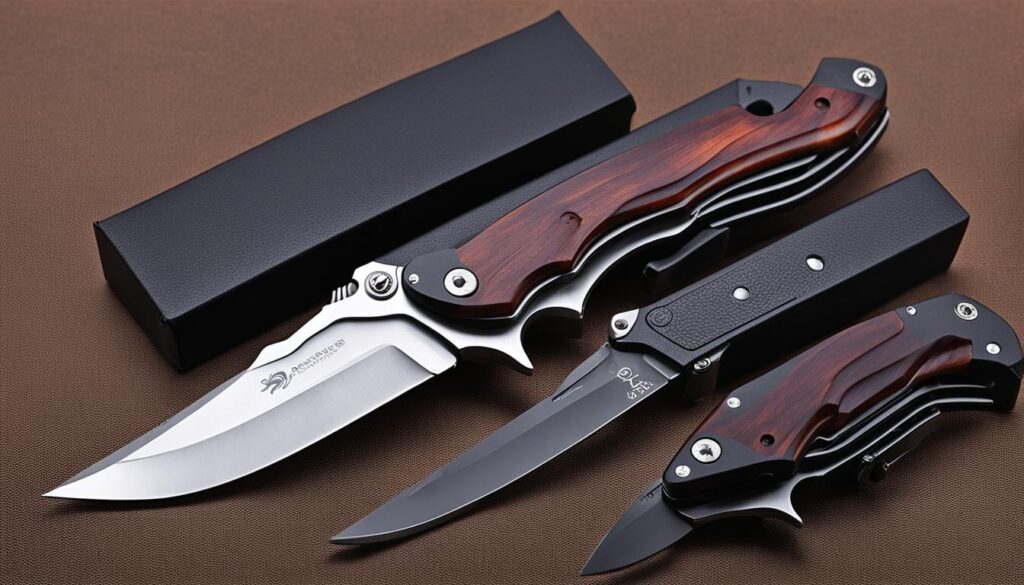
Technology Integration and Sustainability in Folding Knives
As the world becomes increasingly connected, the integration of technology into everyday objects has become a prevalent trend. Folding knives are no exception. Some brands are exploring the possibilities of smart folding knives that offer additional functionality beyond their traditional uses. These smart folding knives may incorporate features such as GPS tracking, LED lights, and emergency tools, providing users with a versatile tool for various situations.
However, while technology integration in folding knives offers exciting possibilities, it also presents challenges. Increased complexity and compatibility issues are common hurdles that manufacturers face when incorporating technology into these tools. Additionally, regulatory restrictions surrounding certain features can limit the capabilities of smart folding knives. Nevertheless, the knife industry is continuously striving to overcome these challenges and push the boundaries of what is possible with technology integration.
Integrating technology into folding knives has the potential to revolutionize the way we use these tools. With GPS tracking, outdoor enthusiasts can keep track of their knives in case of loss or theft. LED lights can provide illumination for tasks in low-light conditions, while emergency tools like glass breakers and seatbelt cutters can be vital in life-saving situations.
Alongside the integration of technology, sustainability and eco-friendly practices are gaining traction in the folding knife industry. Manufacturers are recognizing the importance of reducing their carbon footprint and promoting a greener approach to knife production. This includes using recycled and reclaimed materials in knife construction and implementing efficient manufacturing processes that minimize waste and energy consumption.
Sustainable Innovations in Folding Knife Manufacturing
To further promote sustainability, some brands are exploring eco-friendly innovations in folding knife production. For example, companies are experimenting with alternative materials derived from renewable sources, such as bio-based plastics and plant-based composites. These materials offer similar performance characteristics to traditional handle materials while reducing reliance on fossil fuels.
- Table:
- Smart folding knives vs. traditional folding knives
- Features
- Traditional folding knives
- Smart folding knives
- GPS tracking
- No
- Yes
- LED lights
- No
- Yes
- Emergency tools
- No
- Yes
While these sustainable and eco-friendly innovations in folding knife manufacturing are still in their early stages, they showcase the industry’s commitment to reducing its environmental impact. As technology continues to advance and sustainability remains a top priority, the future of folding knives looks to be greener, smarter, and more functional than ever before.
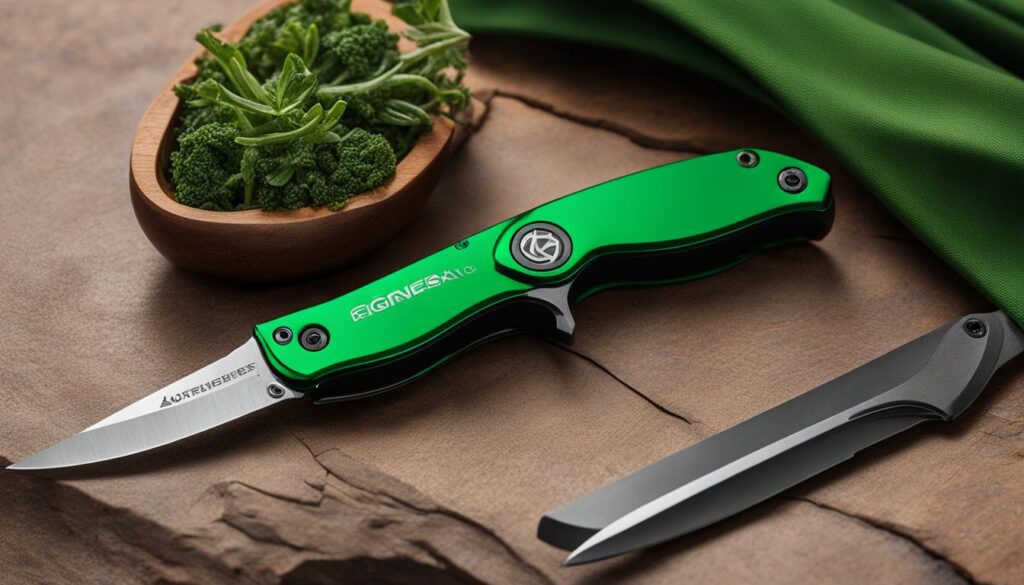

Conclusion
After exploring the world of ergonomic and lightweight hunting knives, it is clear that handle design, blade materials, and overall craftsmanship play a vital role in the performance and usability of these tools. The importance of a well-designed ergonomic handle cannot be overstated, as it not only provides comfort but also ensures safety and efficiency during use.
Design innovations have revolutionized folding knives, with improved locking mechanisms and opening systems that enhance performance and safety. These innovations, coupled with advancements in blade steels and handle materials, have resulted in knives that are durable, corrosion-resistant, and easy to maneuver.
Technology integration has also made its way into the folding knife market, offering additional functionality such as GPS tracking, LED lights, and emergency tools. While these features provide added convenience, they come with their own challenges, including increased complexity and compatibility issues.
As the industry continues to evolve, sustainability and eco-friendly practices are gaining traction. The use of recycled and reclaimed materials, as well as efficient manufacturing processes, are becoming more prevalent. However, there is still room for improvement in terms of sustainable practices and the integration of technology.
FAQ
What role does the knife handle play in the overall performance of a hunting knife?
The knife handle plays a crucial role in the overall performance and usability of a hunting knife. It affects comfort, safety, and efficiency during use.
How does a well-designed ergonomic handle benefit the user?
A well-designed ergonomic handle provides a firm and reliable grip, reducing the risk of accidents and repetitive strain injuries.
What materials are commonly used for knife handles?
Knife handles can be made from various materials, including wood, bone, high-tech materials like G10, and synthetic materials like micarta.
What are the pros and cons of wooden handles?
Wooden handles offer traditional aesthetics and durability but may require more maintenance compared to synthetic materials. They can also be affected by moisture.
What are the advantages of synthetic handles?
Synthetic handles, made from materials like G10 and micarta, offer modern durability and moisture resistance. They are often lighter in weight compared to other materials.
What materials are commonly used for tactical knife handles?
Tactical knife handles are often made from steel and plastic to provide strength and ergonomic grip.
What is the benefit of advanced blade steels in tactical knives?
Advanced blade steels, such as 5Cro13Mov steel, contribute to the knife’s durability, corrosion resistance, and edge retention.
What locking mechanisms are commonly used in folding knives?
Common locking mechanisms in folding knives include the liner lock and frame lock, which ensure blade stability during use.
What are some design innovations in folding knives?
Design innovations in folding knives include improved blade steels, lightweight handle materials like G10 and carbon fiber, and various opening systems like thumb studs and flipper tabs.
Are there folding knives that integrate additional technology?
Yes, some folding knife brands are exploring technology integration to offer additional functionality, such as GPS tracking, LED lights, and emergency tools.
How important is sustainability in the knife industry?
The knife industry is recognizing the importance of sustainability and eco-friendly practices, promoting the use of recycled and reclaimed materials and efficient manufacturing processes.
